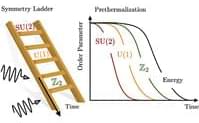Join us on Patreon! https://www.patreon.com/MichaelLustgartenPhDDiscount Links/Affiliates: Blood testing (where I get the majority of my labs): https://www.u…
Get the latest international news and world events from around the world.
NASA’s X-43A: The Mach 9.6 Hypersonic Marvel
Key Points and Summary: NASA’s X-43A hypersonic research aircraft made history in 2004 by reaching Mach 9.64, or 6,363 mph, at an altitude of 110,000 feet.-Powered by a cutting-edge scramjet engine, the X-43A demonstrated the efficiency of air-breathing propulsion for hypersonic flight.-Developed as part of NASA’s “better, faster, cheaper” program, the X-43A was […].

NVIDIA GTC 2025: Quantum Day to Illuminate the Future of Quantum Computing
It’s expected that the technology will tackle myriad problems that were once deemed impractical or even impossible to solve. Quantum computing promises huge leaps forward for fields spanning drug discovery and materials development to financial forecasting.
But just as exciting as quantum computing’s future are the breakthroughs already being made today in quantum hardware, error correction and algorithms.
NVIDIA is celebrating and exploring this remarkable progress in quantum computing by announcing its first Quantum Day at GTC 2025 on Thursday, March 20. This new focus area brings together leading experts for a comprehensive and balanced perspective on what businesses should expect from quantum computing in the coming decades — mapping the path toward useful quantum applications.


Webb telescope directly observes the origin of carbon in the universe
Astronomers have long sought to find the origin of the building blocks of life, and how elements like carbon, which are essential for life, spread across the universe.
Recent findings using data from NASA’s James Webb Space Telescope have unveiled a fascinating process in action.
In the Milky Way, 5,000 light-years away, two massive stars in the Wolf-Rayet 140 system are spewing out massive amounts of carbon-rich dust.


Engineering Hierarchical Symmetries
Symmetry plays a crucial role in understanding fundamental phenomena such as conservation laws, the classification of phases of matter, and their transitions. Recently, researchers have been exploring ways to manipulate symmetries in quantum many-body systems with time-dependent driving protocols and, in particular, engineering new symmetries that do not naturally occur. This significantly enriches the toolbox for quantum simulation and computation, and has led to many exciting discoveries of nonequilibrium phases such as discrete time crystals. However, controlling multiple symmetries—especially in a simple and experimentally friendly way—has remained a challenge. In this work, we propose a novel method to engineer hierarchical symmetries by time-dependent protocols.
By carefully controlling how symmetry-indicating observables evolve over time, we show how to create a sequence of symmetries that emerge one after another, each with distinct properties. Our method relies on a recursive construction that hierarchically minimizes the effects of symmetry-breaking processes. This leads to a corresponding sequence of prethermal steady states with controllable lifetimes, each exhibiting a lower symmetry than the preceding one. We illustrate this protocol with several examples, demonstrating how different types of order can emerge through hierarchical symmetry breaking.
This toolbox of hierarchical symmetries opens a new path to stabilizing quantum states and controlling unwanted symmetry-breaking effects, which can be particularly useful in quantum computing and quantum simulation. The construction applies to classical and quantum, fermionic and bosonic, interacting and noninteracting systems. The underlying mechanism generalizes state-of-the-art dynamical decoupling techniques and is implementable on present-day quantum simulation platforms.

People left horrified after finding out your tonsils can grow back despite being removed
Link :
That was quite the scare for one US woman who was told she needed to have hers removed, despite having had them removed 40 years earlier.
Katy Golden told CNN: “I knew that there was some sort of little flap or something that’s been there for years, but I didn’t realize what it was. I just thought, ‘I’m not a doctor myself. I don’t know much about mouth structure. That’s just how it is’.”
Astronomers may have detected a ‘dark’ free-floating black hole
Scientists estimate there are 200 million black holes scattered across the Milky Way galaxy!
